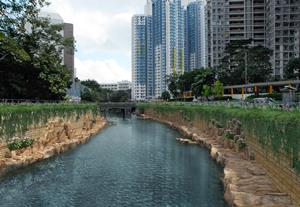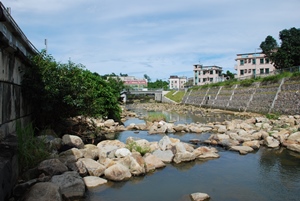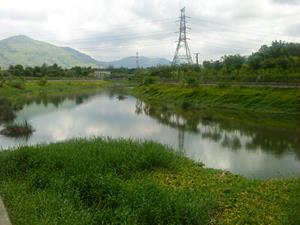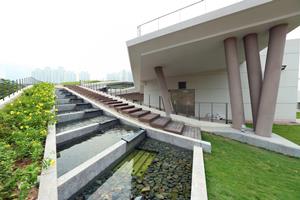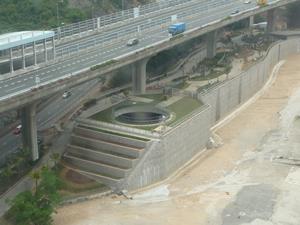Sustainable flood prevention and drainage systems
|
The Hong Kong Observatory predicts that the rainfall this year will be normal to low. However, abnormal weather conditions, such as heavy rainstorms, may still occur. For instance, more than 150 millimetres of rainfall were recorded in some parts of the New Territories late last month during the Black Rainstorm Warning Signal, the first ever issued in March. In this regard, before the wet season approaches every year, our colleagues in the Drainage Services Department (DSD) will step up checking and clearing the stormwater drainage system in each district to keep the drains free from blockage. Apart from carrying out flood prevention tasks, we will also make the most of the opportunities presented by the planning and designing of various works projects in order to build a sustainable flood prevention and drainage system for the community. After almost a quarter of a century’s hard work, the DSD has completed major flood prevention works amounting to some $23.9 billion and has eliminated 120 flooding blackspots so far. Noticeable improvements have been made in many well-known flooding blackspots in the past, such as Yuen Long, Kam Tin, Sheung Shui, Ta Ku Ling, Sheung Wan and Mong Kok. Currently, of the 11 flooding blackspots left in Hong Kong, four have been commissioned with flood prevention improvement works. We are monitoring the effectiveness of these works and will remove the blackspots from the list in due course. For the remaining seven blackspots, improvement works are being carried out at two of them, while phase one works have been commissioned at the other five, with the planning and design work for the next phase in progress. There are different approaches to flood prevention in the urban areas and in the New Territories. Since the urban areas are densely populated and limited in space, distinct flood prevention strategies have to be taken, including the construction of drainage tunnels, stormwater storage tanks and stormwater pumping stations, with a view to redistributing the stormwater, minimising the amount of drainage works to be carried out at busy road sections in the urban areas, and reducing the impact on traffic. For example, the Stormwater Storage Schemes in Tai Hang Tung and Sheung Wan have effectively resolved the flooding problems in Mong Kok and Sheung Wan respectively. With the commissioning of the drainage tunnels in Hong Kong West, Lai Chi Kok and Tsuen Wan, stormwater flowing from uphill to the downstream urban areas will be intercepted and discharged directly to the sea. As a result, the amount of runoff flowing through the downstream urban areas of Sheung Wan, Central, Admiralty, Wan Chai and Happy Valley, Lai Chi Kok, Cheung Sha Wan and Sham Shui Po, as well as Tsuen Wan and Kwai Chung, will be substantially reduced, thus considerably enhancing the flood prevention capacity of these areas. For the New Territories, river training is the major flood prevention measure due to the abundance of streams and rivers there. Our works at the Kam Tin River, the Shan Pui River, the Shenzhen River, the Ng Tung River and the Sheung Yue River have been completed progressively, and the flooding problems in Yuen Long, Sheung Shui and Ta Ku Ling have been improved substantially. We also completed drainage improvement works in Shuen Wan, Tai Po, early this year, which will further reduce the risk of flooding in Tai Po. Looking ahead, the $12 billion flood prevention works of the DSD currently in the planning, design and construction stages will further enhance the flood prevention capacity of Hong Kong. On Hong Kong Island, the Happy Valley Underground Stormwater Storage Scheme will mitigate the risk of flooding in the area and the nearby Wan Chai area. In Kowloon, improvement works for the upper and mid-stream stretches of the Kai Tak River can enhance the flood prevention capacity of the surrounding areas, while other improvement works will also be carried out by the Civil Engineering and Development Department at the lower stream of the Kai Tak River south of Prince Edward Road East at the Kai Tak Development Area. For the New Territories, the Regulation of Shenzhen River Stage IV project will raise the flood prevention capacity of the section of the Shenzhen River between the upstream portion of the Ping Yuen River and the Liantang/Heung Yuen Wai Boundary Control Point. To address the impacts arising from land development, changes of land use in the districts and climate change, the DSD will keep the existing Drainage Master Plans under constant review. For example, the review studies of the Drainage Master Plans in Happy Valley, Yuen Long and North District were completed in 2011. The review studies of the Drainage Master Plans in East Kowloon, West Kowloon, Tai Po, Sha Tin and Sai Kung are in progress, while that for Hong Kong North will commence in mid-2014. We also plan to conduct review studies for Tsuen Wan, Tsing Yi, Tuen Mun, Tseung Kwan O, Hong Kong South, Lantau and outlying islands to review their existing stormwater drainage systems, and to update and formulate flood prevention strategies, in order to minimise the impact of the construction and future operation of flood prevention facilities on the community and environment. To develop a sustainable city and enhance the management of over 300 kilometres of channels and rivers, we will incorporate more “Blue-Green Infrastructure” elements into our flood prevention and drainage systems. “Blue” symbolises water bodies while “green” represents greening and the landscape. In this regard, we will continue to promote conservation while implementing river improvement works. For example, in the Ho Chung River improvement works just completed, we preserved the natural substrates in the river bed and provided aquatic animals with “in stream refugia” and “flow deflectors”, which serve as still water areas and hiding places for fish. In addition, fish ladders were also built in the river to help fish swim back upstream and reproduce in areas with lower water temperature. The Yuen Long By-pass Floodway has been built with shallow ponds to provide a suitable habitat for insects, fish and aquatic plants and attracts birds to find food there. Moreover, a crushed brick field and an oyster shell field serve as natural filters and purifiers for the river water passing by, which can reduce the amount of nutrients in the water and effectively minimise the growth of algal bloom. We will also carry out river works with ecological features, green roofs, porous pavements, which allow water infiltration, and rainwater harvesting systems, and carry out studies for storage lakes to reduce peak flow on the ground at source, so as to provide a more enhanced and natural drainage system which can make our city more “blue and green”. Take the completed Lai Chi Kok Drainage Tunnel as an example. The stormwater collected in the stilling basin will be treated and used for gardening, toilet flushing and street cleansing for the Butterfly Valley Road Pet Garden above, in order to make the best use of our precious water resources. It is, in fact, a prime example of fully utilising our land resources, as the stilling basin of the tunnel was constructed under the viaduct of the Tsing Sha Highway, while the pet garden was built above the basin, thus enabling this piece of land to meet the needs of flood prevention, transportation and recreation at the same time. I believe that we should be proud of the DSD’s contribution and experience in sustainable development. |
|
13 April, 2014
Back